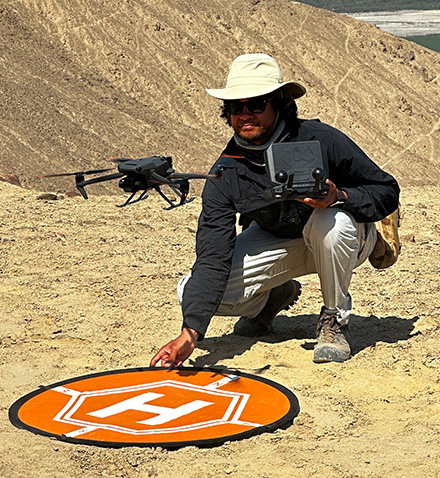By John Dudley, University Communications and Marketing
A century after it first baffled explorers and inspired speculation around its origins, one of South America's most mysterious archaeological sites may finally have a pragmatic explanation.
An international team of archaeologists has uncovered new evidence that the "Band of Holes" - a vast line of more than 5,000 human-carved pits stretching across a hillside in southern Peru - likely were part of an Indigenous system for accounting and exchange centuries before Europeans arrived.

USF anthropologist Charles Stanish
The findings, published this month in the journal Antiquity and co-authored by University of South Florida anthropologist Charles Stanish, combine sediment analysis and drone photography to reinterpret the sprawling site - formally known as Monte Sierpe ("Serpent Mountain") - in the Pisco Valley of the southern Peruvian Andes.
The Band of Holes rose to prominence in 1933 when it appeared in National Geographic aerial photographs. The site - a 1.5-kilometer line of more than 5,200 evenly spaced pits, each about one to two meters wide and up to a meter deep - had puzzled scientists and fueled decades of speculation.
In the absence of clear evidence, theories ranged from the practical - ancient storage or water capture - to the sensational - runways for extraterrestrials. But the new study provides the first hard data supporting an Indigenous explanation grounded in Andean cultural practices.

Aerial of Monte Sierpe [Photo courtesy of C. Stanish]

Close-up of a hole at Monte Sierpe [Photo courtesy of C. Stanish]

Group of holes at Monte Sierpe [Photo courtesy of C. Stanish]

Jacob Bongers of the University of Sydney [Photo courtesy of J. Rodriguez]
Using microbotanical analysis, the research team examined sediment from the holes and found traces of crops such as maize and wild plants traditionally used for weaving and packaging goods.
"These data support the hypothesis that during pre-Hispanic times, local groups periodically lined the holes with plant materials and deposited goods inside them, using woven baskets or bundles for transport," said lead author Jacob Bongers of the University of Sydney, who studied under Stanish at UCLA.
The team also used drones to capture high-resolution aerial images, revealing striking patterns in how the holes were organized. The rows appear segmented and mathematically structured - a layout that mirrors khipus, knotted-string devices the Inca used for counting and recordkeeping.
Taken together, the microbotanical and aerial evidence suggest that Monte Sierpe functioned as a monumental system of accounting that was likely tied to Inca tribute collection or regional trade administered by the state.
The findings point to a fact-based explanation that Stanish suggests helps restore the site to its rightful cultural and historical context.
"The Band of Holes has long been prominent in the pseudo-archaeology world, with rampant speculation and mischaracterization of the data on the ground," said Stanish, who has studied Andean civilizations for more than 30 years. "One of the benefits of scientific work is the debunking of unsubstantiated claims that in many ways deprive Indigenous peoples of rightful ownership of their past."
Stanish adds that, until recently, the site's true structure was nearly impossible to discern.
"Monte Sierpe is extremely difficult to map from the surface," he said. "Even from the mountain above, you can't see its full pattern because of the permanent haze in the area. And because there were few artifacts, archaeologists couldn't date or interpret it accurately."
That changed with the advent of affordable drone technology. With access to precision, low-altitude images, "it was immediately clear that this site was profoundly important and had to be scientifically studied," Stanish said.
The new data show that the holes are not random or decorative but organized in deliberate blocks that may have represented quantities of stored goods or tallied exchanges between communities.
Monte Sierpe sits between two known Inca administrative centers and near the intersection of pre-Hispanic roads - a transitional ecological zone between the Andes highlands and the coastal plains where groups from both regions would have met to trade.
Researchers believe the site was first used by the pre-Inca Chincha Kingdom as a regulated marketplace and later adapted by the Inca Empire as part of its state-run system of storage and redistribution.
Bongers said the findings show how past communities modified their landscapes to bring people together and promote interaction.
"Our findings expand our understanding of barter marketplaces and the origins and diversity of Indigenous accounting practices within and beyond the ancient Andes," Bongers said.
Now that the site's likely purpose has been established, researchers plan to build on the work by studying the types and origins of plants found in the holes - including those with potential medicinal properties.
"With every identification of a new plant type, the Band of Holes becomes more intriguing," said Stanish, adding that further study could help researchers better understand what was being stored or traded at the site, and what that suggests about the economic and cultural networks that once linked the Andes.






